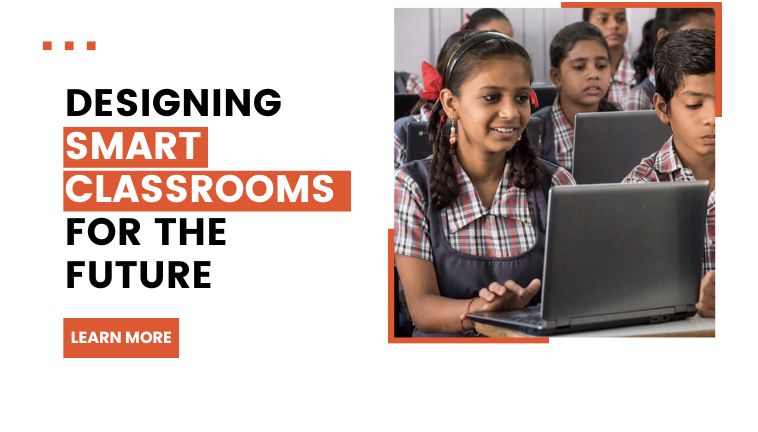Blogs
Designing Smart Classrooms for the Future

In today's digital era, classrooms are being transformed. With technology getting better and better, the concept of "smart classrooms" is slowly but steadily beginning to gather steam. These classrooms use teacher-friendly technology to make learning more fun, get students more interested, and help them learn skills they need for the modern world. This blog will delve into the important requirements to think about when designing smart classrooms for the future.
Evolution of Education Technology
Before getting into the nitty-gritty of a smart classroom design, it's crucial to grasp the background and progression of educational technology. Over recent decades, the incorporation of technology in education has undergone a remarkable evolution, including:
- Computers in the Classroom: The introduction of personal computers into education marked a significant move towards digital learning. These devices allowed students and educators to explore various educational software, conduct online research, and develop digital literacy skills. Computer labs became a common feature in schools, providing access to technology previously confined to specialized settings.
- Internet Connectivity: The advent of the internet revolutionized education by offering access to a vast bank of information, research materials, and collaboration tools. Online learning platforms and digital libraries emerged, providing an extensive array of educational resources. The internet facilitated global communication and collaboration, enabling students to connect with peers and experts worldwide.
- Interactive Whiteboards: Interactive whiteboards replaced traditional chalkboards and whiteboards in classrooms, enabling teachers to present content dynamically and interactively. These digital displays facilitated the projection of digital lessons, videos, and multimedia materials, fostering student engagement. They also allowed real-time annotation and interaction, enhancing the immersive nature and effectiveness of lessons.
- Mobile Devices: The widespread availability of smartphones and tablets transformed learning by providing access to educational resources anytime, anywhere. Students could utilize these devices to access textbooks, educational apps, and online courses. Mobile learning became personalized and adaptable to individual student needs, offering a flexible and convenient educational approach. The mobility of these devices also encouraged active learning and collaboration.
- Cloud Computing: Cloud-based platforms revolutionized the storage, sharing, and collaboration of educational content. Teachers and students could access their materials from any internet-connected device, eliminating the need for physical storage and facilitating seamless collaboration. Cloud storage enhanced data security and backup, ensuring the preservation of valuable educational resources.
- Artificial Intelligence (AI): AI-powered tools introduced personalization and data-driven insights into education. These tools analyze students' learning patterns and provide personalized recommendations. Virtual tutors powered by AI offer individualized support and feedback. Additionally, AI-driven data analytics assist educators in tracking student progress, identifying areas for improvement, and adjusting their teaching strategies accordingly, thereby enhancing overall learning outcomes.
- Virtual and Augmented Reality (VR/AR): VR and AR technologies offer immersive and experiential learning opportunities. In virtual environments, students can explore historical sites, conduct scientific experiments, or engage in realistic simulations. AR overlays digital information onto physical objects, enhancing real-world learning experiences. These technologies provide engaging, hands-on learning experiences, making complex concepts more understandable and memorable for students. They also facilitate virtual field trips, bringing distant places and cultures into the classroom.

Key Components of Smart Classrooms
Creating a smart classroom experience means integrating evolving technologies into a seamless and effective learning space. Here are the essential components to keep in mind:
- Reliable Connectivity: A strong internet connection is the foundation of any smart classroom. High-speed Wi-Fi ensures uninterrupted access to online resources, seamless collaboration, and engaging interactive activities.
- Interactive Displays: Interactive displays or digital whiteboards take the place of traditional chalkboards and projectors. These touch-sensitive screens empower teachers to present digital content, annotate lessons, and encourage student involvement.
Schoolnet’s Interactive Flat Panel display brings the 4-D experience into the classroom with stunning visuals that only captivate the entire class but also make teaching an extremely rewarding experience.
- Student Devices: Equipping students with individual devices like tablets or laptops promotes personalized learning. These tools facilitate research, collaboration, and access to digital textbooks and educational apps
With Schoolnet’s Geneo solutions, students are provided with all the tech-friendly tools like clickers, chromebooks etc. to make the in-school and after-school learning equally engaging and interactive.
- Flexible Furniture: Future classrooms should feature adaptable and modular furniture that can be easily rearranged to suit different teaching methods and activities. Versatile seating arrangements foster collaboration and flexibility.
- VR and AR Tools: Virtual and augmented reality tools offer immersive learning experiences. Students can explore historical sites, dissect virtual organisms, or participate in lifelike simulations that enhance understanding and retention.
- AI-Powered Personalization: Adaptive learning platforms driven by AI analyze student data and tailor content to individual learning styles and progress. This ensures that each student receives a personalized educational experience.
- Cloud-Based Resources: Storing educational materials and resources in the cloud enables access from anywhere. It streamlines collaboration and file sharing among students and teachers.
- Video Conferencing and Collaboration Tools: Incorporating video conferencing and collaboration tools allows for virtual guest speakers, remote learning opportunities, and real-time collaboration with peers worldwide.
- Security Measures: As connectivity increases, cybersecurity becomes critical. Smart classrooms must implement robust security measures to safeguard sensitive student data and mitigate cyber threats.
Advantages of Smart Classrooms
Embracing smart classrooms brings a multitude of benefits for both students and educators:
- Enhanced Engagement: Interactive technology and immersive experiences seize students' attention, making learning more captivating and enjoyable.
- Personalized Learning: AI-powered tools customize content to suit individual learning styles and progress, ensuring no student is left behind or held back.
- Global Collaboration: Smart classrooms facilitate collaboration among students from diverse backgrounds, fostering cultural awareness and global competency.
- Efficiency and Productivity: Teachers can streamline administrative tasks, access digital resources instantly, and dedicate more time to instructional activities.
- Data-Driven Insights: Smart classrooms gather data on student performance and engagement, empowering educators to tailor instruction and pinpoint areas for improvement.
- Preparation for the Future: Exposure to advanced technology in the classroom equips students with the skills needed for the technology-driven workplaces of tomorrow.
In Conclusion
Designing future classrooms signifies a transformative shift in education. It utilizes technology to create captivating, tailored, and globally connected learning spaces. While there are hurdles to overcome, the potential benefits for both students and educators are considerable.
In our ongoing journey at Schoolnet, integrating technology into education isn't merely advantageous but essential to ready students for a swiftly evolving world.
Smart classrooms aren't just a passing trend-word; they epitomize the future of education, reshaping how we acquire, share, and apply knowledge in contemporary times. By investing in smart classroom design, we're not just adapting to change; we're investing in the very essence of education, ensuring students are equipped with the skills and knowledge vital to thrive in an increasingly digital and interconnected era.





